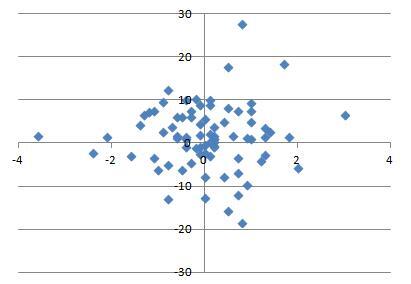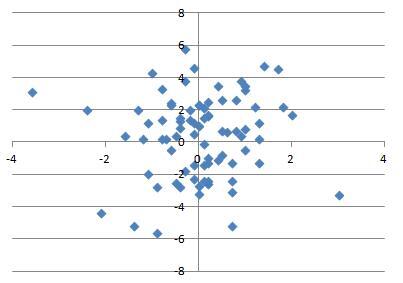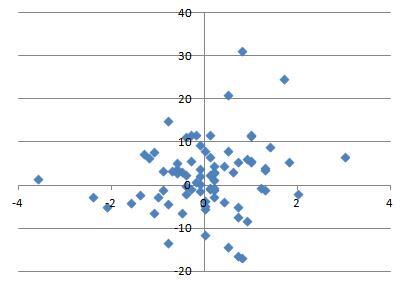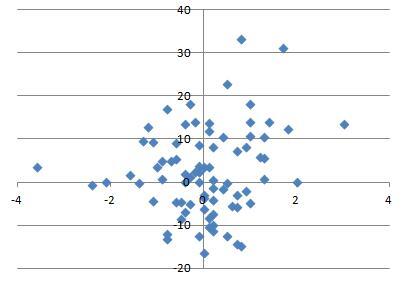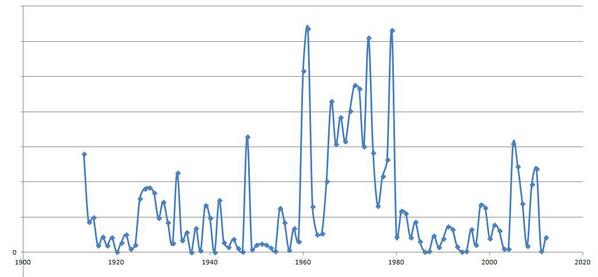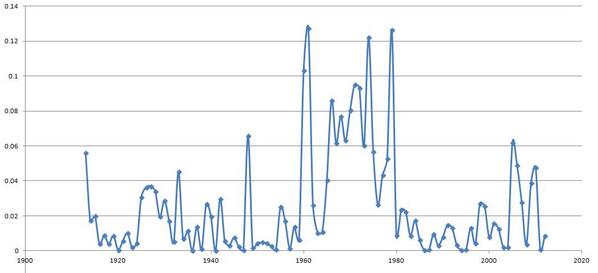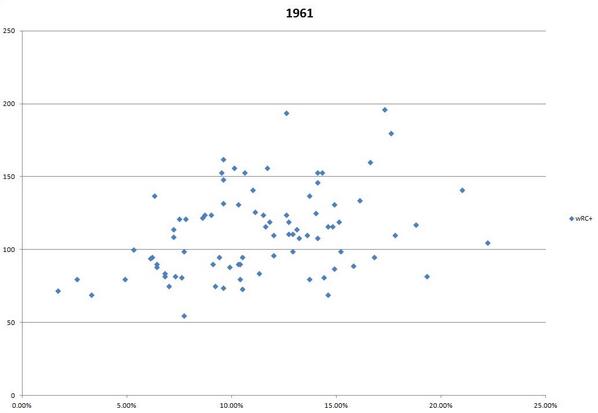The Silver Sluggers: Another Award to Get Angry About!
Note: I have no idea if I’m the first to do this, but quite frankly I don’t care.
Every year, the Gold Gloves are awarded, and people get pissed off about whom they are awarded to. Every year, the Silver Sluggers are also awarded, and…well, no one really gives a fuck about the Silver Sluggers. Why? Hell, I don’t know. They don’t have the “storied tradition” of the Gold Gloves, the “time-honored legends” or the…uh…”legendary honors”? Look, people like to use weird cliches about how things used to be, and then Mike Bates writes quasi-racist articles¹ about it.
Personally, I enjoy the Silver Sluggers–sarcastically using them as superlatives for a player (“He’s won four, he must be good!”), looking forward to the nominations and announcements of the winners, but most importantly, arguing over them. It’s no secret that most awards are controversial–not just in baseball, but in all walks of life. People have differing opinions, and the technology available today makes it easier than ever for those opinions to be spouted furiously for the whole world to hear. In baseball, though, we are different. We have FACTS! We have EVIDENCE! We have STATISTICS!
What was the point of that disjointed rant? As I mentioned earlier, there has been many a bad pick for the Gold Gloves. However, the same is also true for the Silver Sluggers, and aside from Jeff Sullivan, no one seems to give a damn about it. Well, given that I am no one (see what I did there?), I decided that a damn should be given about it. I tracked down all of the Silver Slugger winners, back to 1980 (when they were first awarded), and saw if their wRC+ was the best at their respective position². What did I find?
Well…There were quite a few snubs. There are now 34 seasons of Silver Sluggers, which means there are 613³ Silver Slugger winners. Of those, 226 (36.9%) were undeserving by my methodology. Most of these were forgivable oversights, but some were simply awful choices; I have presented to you today several of the latter, for your viewing pleasure.
Below, you’ll see the 10 worst Silver Sluggers of all time, as measured by difference between the winner’s wRC+ and the deserved winner’s wRC+.
10. AL Outfield–1991
Winner: Joe Carter (123 wRC+)
Deserving Winner: Danny Tartabull (168 wRC+)
In his last season with the Royals before he headed to the Bronx (and to Seinfeld), Tartabull had the best season of his career, putting up 4.5 WAR for the Royals despite accruing only 557 plate appearances. His fielding was just as poor as it had ever been (-21 Def), meaning that all of his excellence had to be derived from his offense, and it was. In those 557 plate appearances, he batted .316/.397/.593, for a .430 wOBA and a 168 wRC+, highest among all outfielders. But was he good enough to win the award that is given to the best offensive players? Evidently not, as that honor went to Joe Carter and his .273/.330/.503 triple-slash, .361 wOBA, and 123 wRC+. Tartabull was clearly superior to Carter, so why did he get robbed?
It wasn’t for a lack of consistent position–although he would become a full-time DH later in his career, Tartabull started in right field for 124 of the 132 games that he played. Looking at traditional stats, Carter is only marginally better than Tartabull (33 HRs and 108 RBIs for the former, 31 HRs and 100 RBIs for the latter), and he still had a 43-point lead in batting average. Neither of them had won any Silver Sluggers prior to this, although Carter would win one the following year⁴. In this case, I suppose the voters picked Carter because he played the most, even if his aggregate offense was worth less than half that of Tartabull (23.4 wRAA to 47.9 wRAA). As you’ll soon see, this oversight was acceptable compared to some of the other egregious ones.
9. AL Designated Hitter–1998
Winner: Jose Canseco (110 wRC+)
Deserving Winner: Edgar Martinez (156 wRC+)
The 35-year-old Martinez was still going strong at this point, putting up at least 5 WAR for the fourth of six consecutive years. His 5-win season in 1998 was primarily based on his ability with the bat, as he played 150 of his 154 games at DH. The Mariners were certainly happy with his production, as he hit .322/.429/.565, for a .427 wOBA and a 157 wRC+. However, a certain time-traveling outfielder was instead rewarded with the Silver Slugger, and it’s not hard to see why.
While Martinez hit for a good amount of power, Canseco outslugged him by a mile, or at least in the one area the voters care about. Martinez only had 29 round-trippers, compared to 46 for Canseco. Yes, Canseco also only batted .237 with a .318 OBP, .354 wOBA, and 110 wRC+, but that’s not important–he hit 46 dingers!
Reputation probably didn’t play a huge role with this one, as each player had won three times before (1992, 1995, and 1997 for Martinez; 1988, 1990, 1991 for Canseco⁵). The (theoretical) ability to drive in runners also wasn’t important, as the two players had nearly identical RBI lines (102 for Martinez, 107 for Canseco); moreover, both were equally durable (672 PAs for Martinez, 658 PAs for Canseco). In the end, the ability to hit the ball out of the park was what stole the award from Martinez, even though both rate stats and cumulative stats (12.7 wRAA for Canseco, 53.5 for Martinez) agreed that other factors were important as well.
8. AL Third Base–1995
Winner: Gary Gaetti (111 wRC+)
Deserving Winner: Jim Thome (158 wRC+)
In his first season qualifying for the batting title, Thome didn’t disappoint, as he gave the Indians six wins above replacement level; he was solid with the glove (1.1 Def at third), but his work with the bat set him apart: He smashed 25 home runs in 557 plate appearances, while hitting .314/.438/.558 with a .433 wOBA and 158 wRC+. Nevertheless, he would be disappointed at season’s end–no, not because the Indians lost the World Series, but because he got robbed of an award to measure the best offensive players at any given position!
Anyway, while Thome’s blossoming power was nothing to shrug at, Gaetti’s power was even more impressive, as he hit 35 homers in only 21 more plate appearances. However, his game suffered everywhere else, as he batted only .261, got on base at a .329 clip, and had a wOBA and wRC+ of .360 and 111, respectively. Both of them played the majority of their games at third base, so both were judged against each other; Thome, though, was unarguably better, which was reflected in wRC+ and wRAA (46.2 for Thome, 13.1 for Gaetti). However, the voters have a tendency to not listen to rational arguments, so Gaetti’s superior home run and RBI totals (96 compared to 73 for Thome) gave him the sought-after crown.
7. AL Outfield–1994
Winner: Kirby Puckett (124 wRC+)
Deserving Winner: Paul O’Neill (171 wRC+)
Because 1994 was shortened by the strike, counting stats from this season have to be taken with a grain of salt. One counting stat in particular was the deciding factor in this race, and I’ll soon reveal what it was. O’Neill was in pinstripes for the second of nine straight seasons, and he lived up to the lofty standard that the garb carries. In 443 plate appearances, O’Neill had 4.3 WAR, despite a Def of -10.7; this was due, then, to the fact that he demolished his way to a .359/.460/.603 line, with a .450 wOBA and 171 wRC+. But did the voters care? No, because a wife-beater was supposedly better.
Puckett was certainly good in 1994, hitting .317/.362/.540 with a .381 wOBA and 124 wRC+ in 482 plate appearances. O’Neill, though, had more than double the wRAA (43.6 to 19.3), and the sizable wRC+ lead; in addition, ONeill actually outhomered him, 21 to 20, and had the aforementioned advantage in batting average. Going down the Triple Crown checklist, that leaves one category: RBIs. O’Neill brought 83 runners home–an acceptable total, to say the least. Puckett, however, blew him out of the water, with 112 RBIs–in 108 games! That’s pretty impressive, if you care about such things, and God knows the voters care. Hence, the Silver Slugger was not given to its rightful owner, all because of one useless stat.
6. AL Designated Hitter–1996
Winner: Paul Molitor (114 wRC+)
Deserving Winner: Edgar Martinez (163 wRC+)
Should Martinez make the Hall of Fame? Probably. Will he make the Hall of Fame? Given his recent history, I’m inclined to say no. Would winning two deserved Silver Sluggers have helped his case? Well…Again, nobody really cares about this thing, so probably not. But the point of all of these rhetorical questions is: Martinez was a boss in 1996 (as he was in 1998). The second of six straight five-win seasons, Martinez was a full-time DH, meaning that he had to crank out the offense constantly if he wanted to remain a high performer. He most certainly did crank, to the tune of a .327/.464/.595 triple-slash, with a .450 wOBA and 163 wRC+ in 634 trips to the plate. You wouldn’t know that from looking at the awards, though, as the guy that deserves to be in Cooperstown was shut out by the only guy at his position that is in Cooperstown. What caused this?
While Martinez didn’t hit a whole lot of long balls–his .269 ISO was derived primarily from his 52 doubles, not his 26 homers–Molitor was even worse, hitting only 9 round trippers in 728 plate appearances. What the voters proved in 1996 was that they didn’t depend solely on primitive statistics like “home runs” to determine a player’s worth. They used advanced statistics for the modern age, like batting average and runs batted in! In those regards, Molitor had clear advantages over Martinez, with a .341 average and 113 RBIs. Now, Molitor’s dearth of walks and power meant that his OBP and SLG were a mere .390 and .468, respectively, which in turn meant that his wOBA was .372 and his wRC+ was 114, which in turn meant that he was completely inferior to Martinez in rate and counting stats (23.0 wRAA, compared to 62.2 for Martinez), but he had 113 RBIs! And a .341 average! That’s gotta count for something!
This was not, however, the only big-boned brouhaha that brewed in 1996…
5. NL First Base–1996
Winner: Andres Galarraga (123 wRC+)
Deserving Winner: Jeff Bagwell (173 wRC+)
In Bagwell’s second of four 7-WAR seasons, he put up some serious numbers for the Astros, hitting .315/.451/.570 with a .433 wOBA and a 173 wRC+ in 719 plate appearances as a first baseman; with a -7.8 Def, he needed to mash to earn his keep. Galarraga was also a relatively poor defender (-7.5 Def), so the same went for him. He also hit quite well, or so it would appear; his triple-slash was .304/.357/.601, which gave him a .402 wOBA in 691 plate appearances at first–not that far off from Bagwell. Why, then, was the wRC+ gap so large?
‘Twas about the elevation, dearie. Galarraga played for the Rockies, meaning he played half of his games at Coors Field, meaning he was expected to hit like a monster. While the aforementioned batting line was rather good by major-league standards, it was merely adequate by the mountain standard, and his 123 wRC+ and 39.3 wRAA reflected that. By contrast, Bagwell played in the Astrodome half of the time, which was not particularly good to hitters as a whole⁶; thus, his 173 wRC+ and his 60.1 wRAA.
Obviously, the voters were unaware of the effects a player’s home park can have on his all-around production, or else they would have discounted Galarraga’s 47 home runs and 150 RBIs. With this next case (well, these next few cases, really), though, there’s no excuse.
4. NL Pitcher–1985
Winner: Rick Rhoden (18 wRC+)
Deserving Winner: Mike Krukow (71 wRC+)
My theory is that the voters are all secretly supporters of the DH, and they all want to see it implicated across both leagues. How else can you explain 15 of the 34 pitchers (44.1%) that have won being undeserving, or that the four worst picks (of any position) were all pitchers? Anyway, Krukow was quite good (for a pitcher) with the bat in 1985, slugging his way to a .218/.259/.345 line, with a .271 wOBA and a 71 wRC+; looking at more traditional stats, he hit one home run and had three RBIs in 66 trips to the plate. He was also pretty good with the arm, accruing 3.1 WAR in 194.2 innings for the Giants in his second of six years by the bay.
Rhoden was also solid on the mound in his seventh of eight years with the Pirates, putting up 2.6 WAR in 213.1 innings pitched. He won the Silver Slugger the year before (and actually deserved to), so maybe the voters were just lazy and assumed he hit well the next year. Make no mistake, though–he did not hit well at all in 1985. His triple-slash was an anemic .189/.211/.230, meaning his wOBA was .200 and his wRC+ was 18; he also went homerless, and had only 6 RBIs. His offense (or lack thereof) cost the Pirates 7.2 runs, three times that of Rhoden (-2.4). For reasons that escape me, that performance was apparently Silver Slugger-worthy, and now the wrong man has gone home with the award for yet another year. But don’t you worry–it gets much, much worse…
3. NL Pitcher–1998
Winner: Tom Glavine (37 wRC+)
Deserving Winner: Mike Hampton (91 wRC+)
Hampton is best remembered for two things: Signing the largest contract in baseball history (for the time) with the Rockies and proceeding to stink up the joint before getting traded to the Braves; and being a pretty damn good hitter. Like, a better career wRC+ than Ozzie Guillen good. Yeah, that’s a bad comparison to make, whatever. The point is, Hampton could hit, and 1998 was no exception–in his penultimate year with the Astros, he had a .262/.348/.328 batting line, which translated to a .312 average and a more than satisfactory 91 wRC+. Glavine, on the other hand, was a less than satisfactory hitter, both for his career and in this year⁷. He batted a mere .239/.250/.282, which only gave him a .237 wOBA and a 37 wRC+. Cumulative stats reflect this as well, as Hampton’s offense was worth 5.6 runs more than Glavine’s (-1.2 to -6.8 wRAA). Triple-crown stats don’t reveal anything–neither player homered, although Glavine had seven RBIs to Hampton’s two.
The reason for Glavine’s victory here was likely twofold. One, Glavine pitched better than Hampton, with the former’s 2.47 ERA in 229.1 innings dwarfing the latter’s 3.36 ERA in 211.2 innings. Second, Glavine had a better reputation, which is where it gets complicated. See, Hampton was a good hitter, and Glavine wasn’t (as footnote 7 should make perfectly clear); however, according to reputation, both of these men were good hitters (for their position), as they took home a combined nine Silver Sluggers. The difference between the two? 1998 was the end of Glavine’s run of Silver Sluggers, whereas the next year (i.e. 1999) was the first of five straight for Hampton⁸. In this case, Glavine’s notoriety, which was built up prior to 1998, won him the award, while Hampton’s fame won him a few later (see footnote 8).
Without a doubt, the 1998 pitcher’s Silver Slugger was one of the worst in the history of the award. Sadly, there are two years that were even worse.
2. NL Pitcher–1983
Winner: Fernando Valenzuela (20 wRC+)
Deserving Winner: Tim Lollar (78 wRC+)
Lollar’s career was pretty unremarkable–he put up 2.5 WAR in 906.0 innings for four teams. In 1983, he pitched for the Padres, and he was in line with his career numbers–0.4 WAR and a 4.61 ERA in 175.2 innings. At the plate, though, he was a revelation–well, comparatively speaking. He hit .241/.292/.345 in 65 plate appearances, which gave him a .285 wOBA and a 78 wRC+, best in the National League among qualified pitchers. Valenzuela’s career was notably more remarkable, as his career WAR was 38.5 over 2930.0 innings for six teams. In the year in question, he pitched well for the Dodgers, accruing 3.9 WAR over 257.0 innings (with a 3.75 ERA). Hitting did not work out quite as well, to say the least: In 105 plate appearances, his triple-slash was .187/.194/.253, which translated to a .199 wOBA and a 20 wRC+.
Lollar was much better than Valenzuela, by both advanced and basic stats–they both hit one homer, but Lollar had 11 RBIs to Valenzuela’s 7. Lollar’s offense only cost the Padres 1.7 runs below average, whereas Valenzuela’s took nearly 10 runs away from the Dodgers. This is one of the more puzzling awards (though not as puzzling as the next one); my best guess is that Valenzuela rode on the coattails of his incredible rookie year in 1981⁹. Unfortunately, this was not the darkest hour for the prestigious honor that is the Silver Slugger award; no, that time would come six years later, in a travesty greater than any that came before it,
1. NL Pitcher–1989
Winner: Don Robinson (43 wRC+)
Deserving Winner: Bob Knepper (111 wRC+)
Given that Bob Knepper’s career wRC+ is 3–yes, three–I’m inclined to believe that his 1989 season was a fluke. The second-to-last season of his career, 1989 didn’t go well for him as a pitcher–he put up a 5.13 ERA while costing the Astros and Giants -0.8 wins over 165.0 innings. As a hitter, though, he was never better–somehow, he managed to get on base in 32.7% of his trips to the plate, with a decent .372 slugging percentage for good measure. His competence in these two areas was enough to compensate for his sub-Mendozan batting average (.186) and bring his wOBA and wRC+ to .324 and 111, respectively.
The antithesis to this would be Robinson, who was quite good on the mound (at least by traditional stats), with a 3.43 ERA in 197.0 innings for the Giants, but was completely ineffective at the plate (even for a pitcher). The owner of a respectable career wRC+ of 60, Robinson sunk down to 43 in 1989, as he only batted .185/.195/.309 (.226 wOBA). In what world was that worth more than Knepper? A world where the voters for most major awards rely on archaic means of measuring player performance–i.e. homers and RBIs. Knepper only knocked one out once in 55 plate appearances, while Robinson did it thrice in 82 PAs; Robinson also out-ribbied Knepper, seven to three. When the dust had settled, Knepper was worth 0.5 wRAA, while Robinson was worth -5.4; despite this, the Silver Slugger went to Robinson.
***
Having finally finished with this torturous exercise, I now see why people don’t place any value in the Silver Sluggers. They’re pointless awards, given out solely on reputation and not actual performance. Anyone who takes them seriously is just aksing for…Wait, what’s that? The Orioles won HOW MANY Silver Sluggers?
In summation: The Silver Slugger is the best award in baseball, and it’s a shame that the level of respect for it is as low at it is.
———————————————————————————————–
¹Just to be clear: I thoroughly enjoyed the article, and don’t consider Bates to be racist in any way.
²A little bit about the methodology: I decided on wRC+ (as opposed to, say Off) for two reasons. First, I wanted to see who the best hitters were, not the best offensive players, meaning baserunning was not to be included. Is that small-minded? Probably. Is the award in question called the Silver Slugger/Baserunner, and is the award itself a combination of a silver bat and a silver pair of cleats? Certainly not. Second (and more rationally), I wanted to measure the best hitters overall, not in terms of aggregate value; using Off or wRAA would benefit players that played longer. To pull some numbers out of my ass as an example, a guy with a 140 wRC+ is a better hitter than a guy with a 130 wRC+, but if the latter received 700 plate appearances while the former only received 550, Off or wRAA (or any counting stat) wouldn’t reflect that. But, just to be safe, I also put each player’s wRAA somewhere in the writeup.
³In 2004, there were two AL catchers that won–neither of whom was deserving.
⁴That would also be undeserved; Carter’s 120 wRC+ in 1992 paled in comparison to Shane Mack and his 142 wRC+.
⁵Oddly enough, all of those were deserving. Canseco’s wRC+s of 169, 157, and 152 in 1988, 1990, and 1991, respectively, were among the three best among qualified outfielders in those years, and Martinez’s wRC+s of 165, 182, and 164, respectively, were the best among qualifying DHs in those years.
⁶Side note: Why did this never happen? Come on, people–I expected more from you.
⁷Glavine won four Silver Sluggers over the course of his career (in 1991, 1995, 1996, and 1998). Care to speculate as to how many of those were justified? That’s right, none! In those years, Glavine’s wRC+s were 50, 41, 81, and 37, respectively, when Tommy Greene (94 wRC+ in 1991), Kevin Foster (65 wRC+ in 1995), Jason Isringhausen (84 wRC+ in 1996), and Hampton were far better. Also, in case you were wondering, Glavine’s career wRC+ is 22.
⁸Of those five, three (1999, 2001, and 2002, with wRC+s of 111, 106, and 112, respectively) were the right choice, and two (2000 and 2003, with wRC+s of 56 and 52, respectively, when Omar Daal and Russ Ortiz had wRC+s of 83 and 81, respectively) were not.
⁹He won the Silver Slugger in that year as well, and that was also undeserved, as his 55 wRC+ was outshined by Gaylord Perry’s 71 wRC+.
